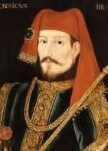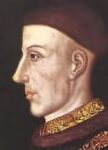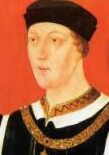The House of Lancaster
The House of Lancaster, a branch of the Plantagenet family, descended from John of Gaunt, Duke of Lancaster, the third surviving son of King Edward III, produced 3 Kings of England- Henry IV (1367 -1413), Henry V (1386 - 1422) and Henry VI (1421 - 1471).
The first Earl of Lancaster was Edmund Crouchback, younger son of King Henry III, Edmund's son Thomas inherited his father's estates in 1296, but was executed in 1322 after he joined a baronial rebellion against his cousin Edward II and his titles and estates were forfeited to the crown. In 1326, Thomas' younger brother Henry successfully petitioned to take possession of the Earldom of Lancaster and Parliament posthumously reversed Thomas's conviction. On Henry's death in 1345 his titles and estates passed to his son, Henry of Grosmont, who was elevated to Duke of Lancaster by Edward III.
Henry had no sons to succeed him but left two daughters, Maud and Blanche of Lancaster. Blanche was married to Edward III's son John of Gaunt, who inherited his possessions and ducal title through right of his wife. On Gaunt's death in 1399, his lands were confiscated by King Richard II. Gaunt's exiled son and heir Henry of Bolingbroke returned to England with an army and took control of the Kingdom. Richard II was deposed and Henry of Bolingbroke was declared King Henry IV. His son, Henry V, was a successful medieval martial ruler. He conquered France in re-assertion of the claim to the French throne he inherited from Edward III and bequeathed to his infant son, the ill-fated Henry VI, two kingdoms and an inheritance that was to prove impossible to maintain.
In 1453, at the age of 32, Henry VI began to exhibit signs of serious mental illness. By means of a "sudden fright", he entered into a trance-like state reacting to and recognizing no one. Catatonic schizophrenia or depressive stupor have been suggested as a likely diagnosis. This was probably an inheritance from his maternal grandfather, Charles VI of France, who himself suffered from bouts of schizophrenia. His cousin Richard, Duke of York, who possessed a slightly senior claim to the House of Lancaster according to cognatic primogeniture, was made Lord Protector, but later laid claim to the throne for himself and his descendants. York was killed at the Battle of Wakefield in 1460, after which the Yorkist claim devolved on his eldest son, Edward Earl of March. Edward deposed Henry VI and was crowned Edward IV in 1461.
Henry's young son, Edward, the Lancastrian Prince of Wales was killed during or after the Battle of Tewkesbury in 1471, Henry VI met his death in the Tower of London, on the night of the Vigil of the Ascension, 21st -22nd May 1471. The demise of his son at Tewkesbury had sealed his fate. While Edward of Lancaster still lived, he had rendered the removal of Henry pointless. The demise of Henry VI and the Beaufort male line left Margaret Beaufort, and her son, Henry Tudor, as the senior representatives of the House of Lancaster. When the last Yorkist king, Richard III was killed in battle at Bosworth Field in 1485. The new king, Henry VII, who represented the Lancastrian line, married Edward IV's eldest daughter Elizabeth of York, thereby uniting the claims of both houses in the person of their son, King Henry VIII.
Monarch
Born and Reign



